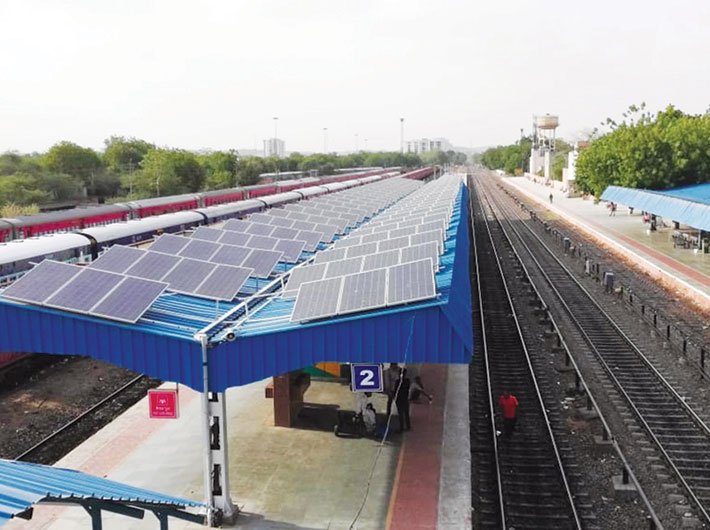If India plans to switch to renewable energy, the railways will have to be on board as it contributes nearly 2 percent in national power consumption
With about 23 million passengers on an average day, the Indian Railways itself is the size of a small country. When India plans to significantly increase the share of renewable energy in its consumption pie, the railways too aims to meet at least 10-15 percent of its energy demand from renewable sources like solar and wind.
Railways minister Piyush Goyal has been giving a push to expand solar and wind energy to meet two types of needs: in traction (that is, electricity needed to run different types of locomotive and multiple units) and in non-traction (that is, electricity meant for the railways’ manufacturing units, workshops, maintenance depots, residences, stations and platforms).
It has been exploring options – from installing rooftop solar panels to windmill energy plants and train-mounted solar panels, as well as collaborating with private players to use railway land for building solar and windmill plants.
Officials say meeting the traction needs of the railways would require a massive renewable infrastructure whereas meeting the non-traction needs is doable which can be met by solar and windmill plants. The railways consumes 2.5 billion units of electricity for its non-traction needs (which has been largely stagnant since 2008 because of energy efficiency efforts).
A report of the railway board’s Electrical Energy Management Directorate (EEMD) says the railways consumed over 18.25 billion units of electrical energy for both its traction and non-traction applications in 2014-15 which is 1.8 percent of total electrical energy generated in the country.
The railways wants to bring down dependence on fossil fuel and set up rooftop and land-based solar plants with a total generating capacity of 1,000 MW under the its ambitious solar mission plan. While the rooftop solar plants (500 MW) would be used to meet non-traction power loads, the land-based plants would cater to the needs of both traction and non-traction.
The national carrier is the largest passenger carrying system in the world and the fourth largest freight transporter globally.
With the surge in passenger traffic, energy needs for electric traction, which constitutes around 85 percent of the railways’ power consumption, has been increasing at a compound annual growth rate of four percent. That is reason enough to prompt the railways to harness green energy to reduce fossil fuel dependence and cut energy bills.
The EEMD report says the railways spent more money to procure electricity for meeting traction needs as the cost of electricity had increased at a CAGR of seven percent between 1987 and 2015.
The plan of commissioning solar plants by developers on the railway land with subsidy or viability gap funding support from the railways ministry in next five years would give an impetus to the India’s quest of generating 100 GW of solar energy under the National Solar Mission.
The railways, which has massive swathes of vacant land, has finalised 450 MW of land-based solar plant projects, to be commissioned in a few years. Efforts are on to set up 250 MW solar plants on its vacant land at Adra in West Bengal.
The railways have also tied up for 400 MW from the Rewa ultra mega solar power plant in Madhya Pradesh to meet its traction power need. A 50 MW solar plant is also being set up on vacant railway land at Bhilai in Chhattisgarh through Railway Energy Management Company Limited (REMCL), a joint venture of the railways ministry with equity participation in the ratio of Indian railways (49%) and RITES Limited (51%).
The work of solar photovoltaic plants on railway buildings’ rooftops, with a total capacity of 130 MW, has been awarded to various private players, whereas REMCL is executing a 323 MW solar plant. Besides, tenders for solar plants totaling 100 MW would be issued soon.
“Rather than sanctioning the project, that is, incurring capital expenditure and then getting captive power, the railways has switched over to a concessioner model in which railway premises are provided to the operator who installs the solar plants. The railways pays for the electricity that the operator supplies to it. It becomes a more output-oriented contract rather than a process-oriented one,” said an official of the environment and housekeeping management (EnHM) directorate of the railway board.
The official gave an example of Katra station which is the only solar energy surplus station. Katra station follows the ‘net metering’ concept which allows the railways to use the power when it needs and give it back to the developer when the power is in surplus, he said. As long as the two are matched, the railways do not need to pay to the developer.
When it comes to wind energy, the railways has planned to set up 200 MW windmill power plants. So far, 36.5 MW windmill plants have been commissioned, including a 10.5 MW windmill plant built at the Integral Coach Factory in Chennai and a 26 MW wind plant built by REMCL in Rajasthan’s Jaisalmer. REMCL is currently working on finalising tenders for harnessing 16.5 MW wind plants in Tamil Nadu and Maharashtra.
The official says installing windmill plants is not an easy task as it requires vast pieces of land and maintenance is a bit expensive too.
That apart, the railways has also installed solar photovoltaic system onto the roof of trailer coaches of one rake of 1,600 horsepower diesel electric multiple unit (DEMU). It fulfills electric supply for the fan, information display system and lighting load inside the coaches.
Sources say the Indian Railways Organisation for Alternate Fuels (IROAF) is mulling to make provision of flexi solar panels on 250 trailer carriages.
DEMU trains are preferred for coach-mounted solar plants as they run on shorter routes during daytime; whereas express trains travel mostly during night.
The train was launched by the then railways minister Suresh Prabhu on July 14, 2017 in New Delhi which plies within Delhi suburbs. ICF Chennai had manufactured this train while solar panels and PV system was installed onto the train by IROAF.
An EnHM directorate official explains that a DEMU train’s lights and fans need power from a diesel-driven generator loaded on its driving power car (DPC). But in the solar powered train, a smart MPPT inverter developed by IROAF optimises power generation on a moving train to cater to full load even during night. The battery installed in the train store adequate power to meet the electric supply when the sunlight is absent. It slashes diesel consumption and cuts carbon emission by reducing CO2 generation by nine tonnes per coach per year.
A solar power DEMU train with six trailer coaches will save about 21,000 litres of diesel which amounts to saving of around Rs 14 Lakh every year. The benefits will continue for entire life time of 25 years of the rake.
Similarly, IROAF has fitted solar panels of 4.8 KW capacity each on 10 coaches of Swachata Express, an exhibition train to showcase the success of Swachh Bharat Mission, which generates 10KW per day to run lights and fans inside the carriages.
Additional director general, information and public relations, Indian Railways, Smita Vats Sharma, told Governance Now that the railways endeavour to expand its renewable energy base in the next five years and concerted efforts are being made by the ministry to realise the dream of harnessing a huge chunk of green energy. It also sought help from The Energy Research Institute (TERI) and other such organisations in developing the strategies for emission reduction by 2030.
Railways figures prominently in India’s plans to combat climate change. The intended nationally determined contributions (INDC) document submitted by India in October 2015 was discussed at the 21st Conference of Parties (CoP 21) organised by the United Nations Framework Convention on Climate Change (UNFCCC) in Paris in November 2015. One of the most important transportation emissions mitigation strategies agreed to by the Indian government was increasing the share of Indian Railways in freight movement from the current 35 percent to 45 percent by 2030. The railways should develop dedicated freight corridors across the country and commission two corridors by 2020. The first phase alone is estimated to cut emissions by 457 million CO2 over a 30-year period.
(The article appears in October 31, 2018 edition)



